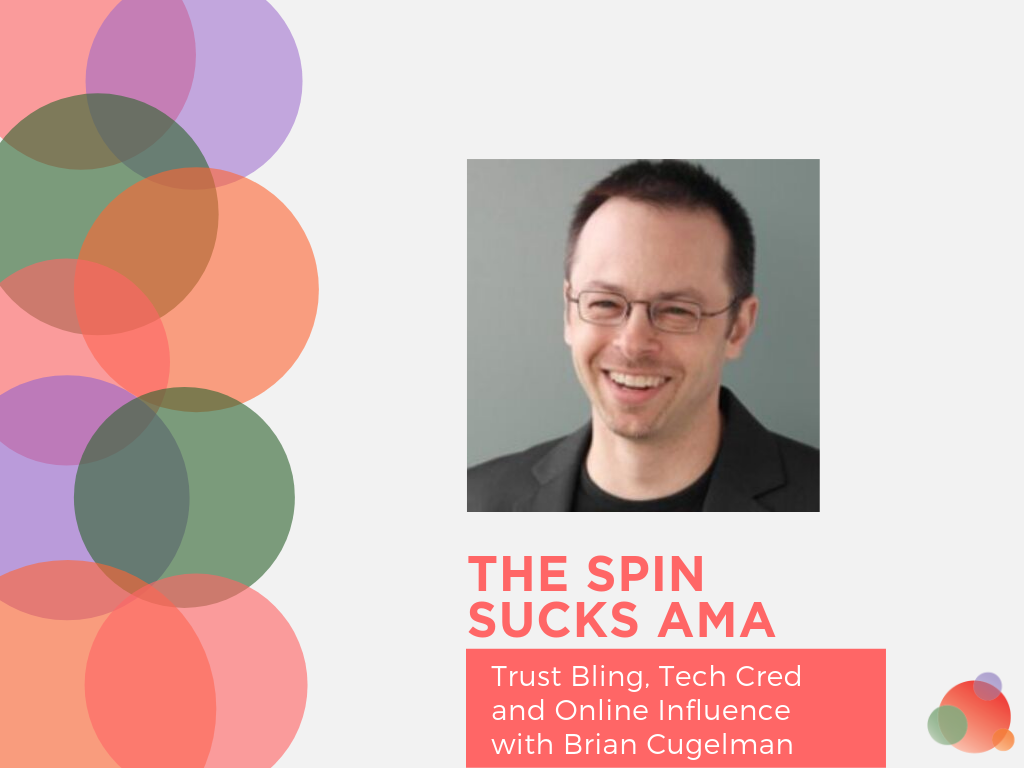 Last month Brian Cugelman, owner of AlterSpark, was our guest on the #SpinSucksAMA.
Last month Brian Cugelman, owner of AlterSpark, was our guest on the #SpinSucksAMA.
Brian’s an online researcher and combines big data with behavioral science to understand why certain messages attract our attention, what types of content are more likely to persuade our customers, and what builds and erodes trust online.
Sound complicated?
I thought so too, but Brian was so great at diving in and breaking down the essentials of this particular topic.
Trust Bling? Is That a Thing?
The title of Brian’s #SpinSucksAMA included the term “trust bling.”
I had never heard the term before, but I immediately loved it.
(Don’t try to act like it’s not fun. It is.)
We asked Brian the meaning behind it:
Trust bling are those little sprinkles like the graphic design items you’ll put around a website to foster trust.
It’s like showy jewelry, showing things off that stand out.
The reason for that is you can demonstrate trust, and target trusted instincts through decorative patterns.
But it’s hard to build someone’s confidence doing that. It’s hard to achieve other psychological impacts for trust.
We can sprinkle on a couple of seals and locks and safety certificates, things like that … showing visuals. That’s why it’s different from the application of other psychological techniques.
Tech Cred and Your Brand
The term “tech cred” seems pretty straightforward, right?
It’s your technology credibility, but what are some ways we can use this to increase brand loyalty?
Brian had the answer:
Credibility of your technology is actually exactly the same as brand credibility. It’s also exactly the same as human credibility.
We’re looking at the credibility of a product, or any digital product or campaign as a person’s trust in the source.
For example, before you would have the source of the message, but now it’s also the trust you have in the app. People get a sense of the person or brand they’re interacting with. That’s tech cred.
Research used to think this was is something distinct, and there are different philosophical and scientific views on this. Essentially, at least in the area of research, technology credibility is exactly like source credibility.
How to Establish Tech Credibility
Now that we’re all clear on exactly what tech cred is, how do we go about making sure our organization has it?
According to Brian:
It’s something we should all be aware of because it all ties back into our identity and our brand.
When tech cred gets into your brand identity and your reputation, these are things that are more the area of public relations. Those will rub off.
If a company has a scandal or something like that, everything they do is tainted with that.
Of course, it also depends on the type of scandal: incompetence versus dishonesty.
When you come down to the level of the interface, you have to show things. To demonstrate honesty, you really have to show a track record. That’s where your reputation comes in.
If you don’t have that, you borrow from other sources because trust can be passed from one source to another.
Things like testimonials, endorsements, and affiliations with pre-existing trusted sources is one way to start establishing that expertise.
You don’t have to have a track record to demonstrate it, you just have to show it.
If you’re doing online marketing, people should be able to come to your online marketing platforms or social media sites and like what they see. They see that you’re competent, so you’re walking the talk in that way.
Of course, there are other testimonials and endorsements. Sometimes I see people are starting out go right to white papers. They do webinars and set up meetup groups around a small company, for example.
Use Visual Design to Increase Your Tech Cred
Because so many of us are visual learners, visual design can be an easy way to increase credibility:
Try to have a visual way to demonstrate anything that relates to honesty or expertise. If you can take something and show people—literally—that’s a good way to establish credibility.
If you have a business, show the business. For products, show those products. Finding a way of visually showing abstract products and services can be harder to demonstrate.
You have to find a symbolic way. What you want to do is make it more tangible. Things should feel like something you can trust, because there’s also product credibility.
This gets into how do you build a phone that is credible. For example, people think that light phones are crappy.
Some phones are made with metal and weights so people feel that weight and think, “Oh, this is a quality product.”
So we take that online. And if you could find appropriate visuals, that’s a very good way to start establishing that tangibility of product.
Video Recap of Brian Cugelman’s AMA
Brian was a wonderful guest and had so much more to say on his topic.
If you’re interested in the full video recap, ask about becoming a member of our #PRDreamTeam.
For now, we’ve included a preview here.
Be on the lookout for our next #SpinSucksAMA.
We’re hosting our very own Laura Petrolino at 2 pm ET today (August 14th), as she talks about the psychology behind marketing campaigns and consumer motivations.
If you’re interested, click here to join our Spin Sucks community and take part in the next #SpinSucksAMA live.
See you there!